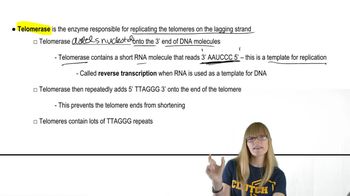There is a problem completing the replication of linear chromosomes at their ends. What is the function of telomerase, and how does it operate to synthesize telomeres?
Table of contents
- 1. Introduction to Genetics51m
- 2. Mendel's Laws of Inheritance3h 37m
- 3. Extensions to Mendelian Inheritance2h 41m
- 4. Genetic Mapping and Linkage2h 28m
- 5. Genetics of Bacteria and Viruses1h 21m
- 6. Chromosomal Variation1h 48m
- 7. DNA and Chromosome Structure56m
- 8. DNA Replication1h 10m
- 9. Mitosis and Meiosis1h 34m
- 10. Transcription1h 0m
- 11. Translation58m
- 12. Gene Regulation in Prokaryotes1h 19m
- 13. Gene Regulation in Eukaryotes44m
- 14. Genetic Control of Development44m
- 15. Genomes and Genomics1h 50m
- 16. Transposable Elements47m
- 17. Mutation, Repair, and Recombination1h 6m
- 18. Molecular Genetic Tools19m
- 19. Cancer Genetics29m
- 20. Quantitative Genetics1h 26m
- 21. Population Genetics50m
- 22. Evolutionary Genetics29m
8. DNA Replication
Telomeres and Telomerase
Problem 26c
Textbook Question
Telomeres are found at the ends of eukaryotic chromosomes. What is the functional role of telomeres?
 Verified step by step guidance
Verified step by step guidance1
Telomeres are repetitive nucleotide sequences located at the ends of eukaryotic chromosomes. They consist of a specific DNA sequence, such as TTAGGG in humans, repeated many times.
The primary function of telomeres is to protect the ends of chromosomes from degradation and prevent them from being recognized as broken DNA by the cell's repair machinery.
During DNA replication, the enzymes responsible for copying DNA cannot fully replicate the very ends of linear chromosomes. This is known as the 'end-replication problem.' Telomeres help mitigate this issue by acting as a buffer zone, ensuring that the loss of DNA during replication does not affect essential genes.
Telomeres also play a role in maintaining chromosomal stability by preventing the ends of chromosomes from fusing with each other, which could lead to genomic instability and cell malfunction.
Over time, telomeres shorten with each cell division, and when they become critically short, the cell may enter a state called senescence (a non-dividing state) or undergo apoptosis (programmed cell death). This process is associated with aging and the regulation of cellular lifespan.
 Verified video answer for a similar problem:
Verified video answer for a similar problem:This video solution was recommended by our tutors as helpful for the problem above
Video duration:
3mPlay a video:
Was this helpful?
Key Concepts
Here are the essential concepts you must grasp in order to answer the question correctly.
Telomeres
Telomeres are repetitive nucleotide sequences located at the ends of eukaryotic chromosomes. They protect the chromosome ends from deterioration and prevent them from fusing with neighboring chromosomes. Each time a cell divides, telomeres shorten, which is associated with aging and cellular senescence.
Recommended video:
Guided course

Telomeres and Telomerase
Chromosome Stability
The stability of chromosomes is crucial for maintaining genetic integrity during cell division. Telomeres play a vital role in chromosome stability by preventing the loss of essential genetic information during DNA replication. Without telomeres, chromosomes would become unstable, leading to genomic instability and potential cell death.
Recommended video:
Guided course

Chromosome Structure
Cellular Aging
Cellular aging, or senescence, is the process by which cells lose the ability to divide and function effectively over time. The progressive shortening of telomeres with each cell division is a key factor in this process. When telomeres become critically short, cells enter a state of senescence, contributing to aging and age-related diseases.
Recommended video:
Guided course

Translesion Synthesis

 8:38m
8:38mWatch next
Master Telomeres and Telomerase with a bite sized video explanation from Kylia
Start learningRelated Videos
Related Practice
Textbook Question
329
views
